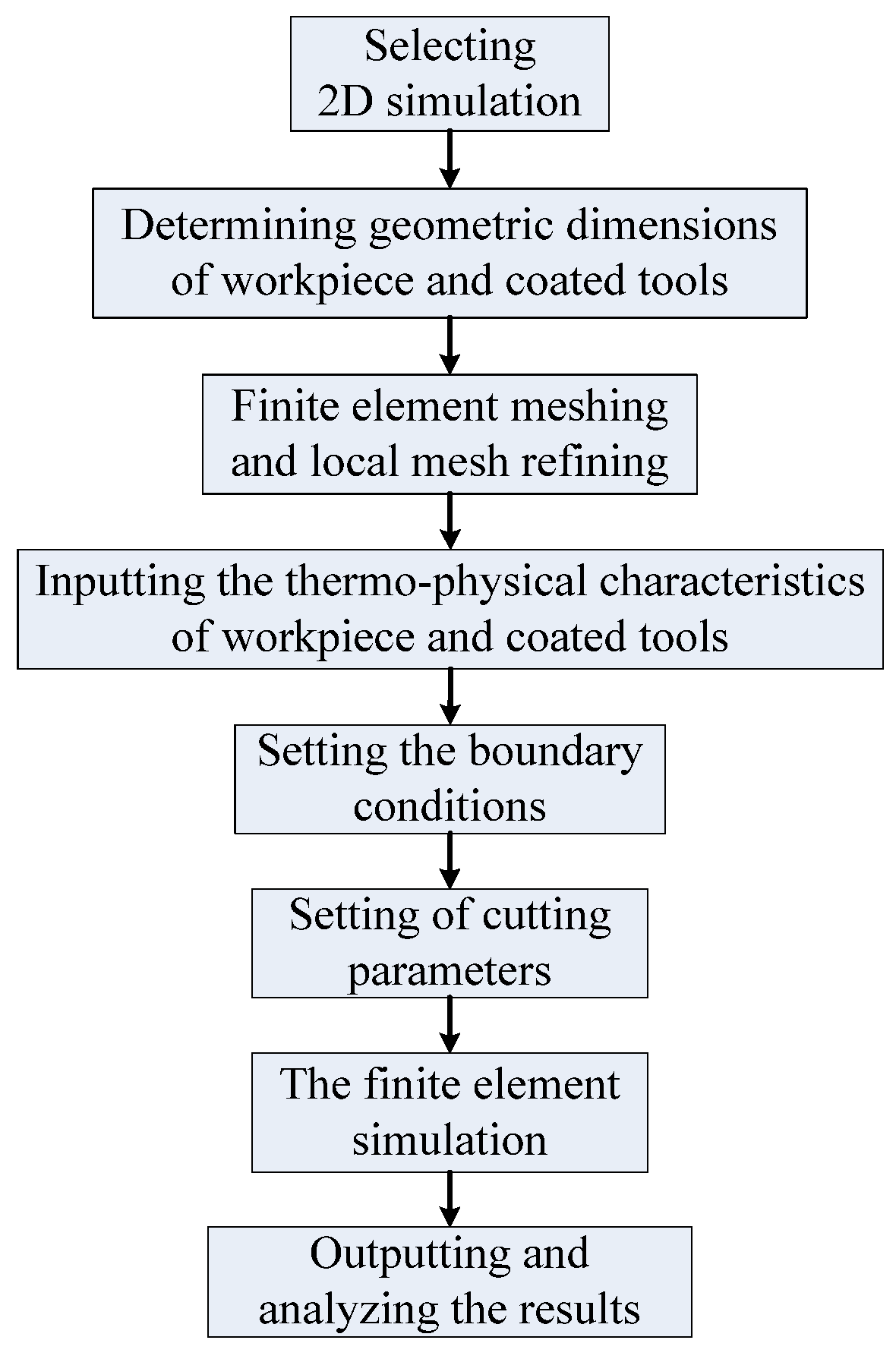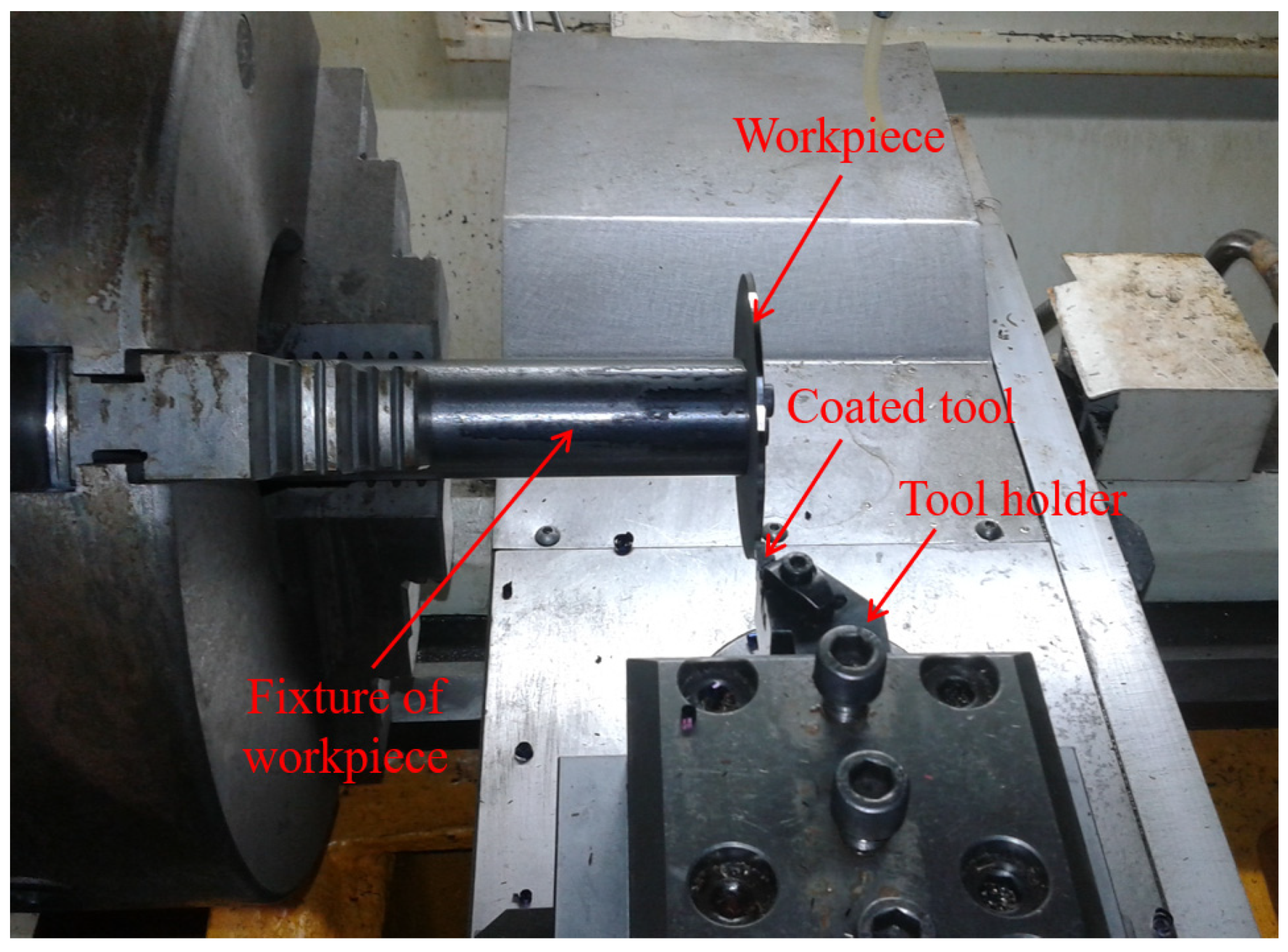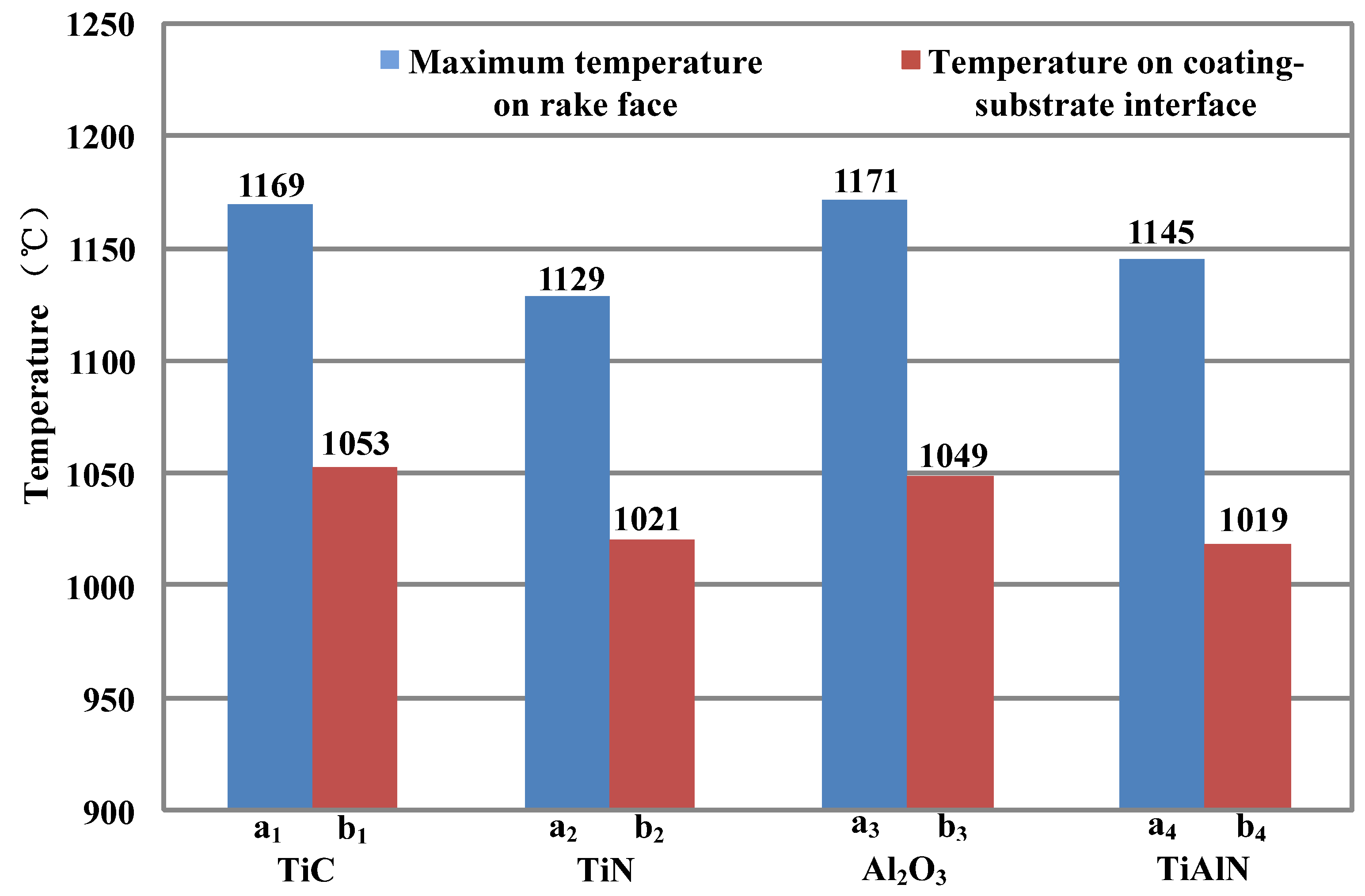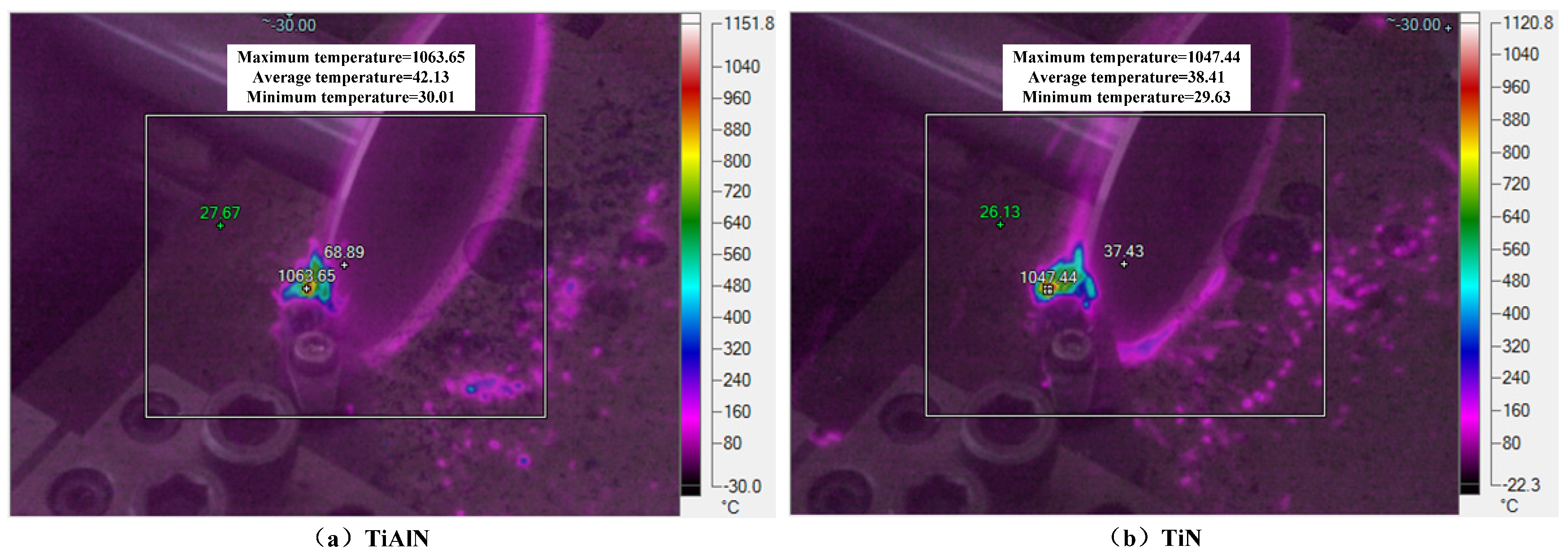Finite Element Simulation of Orthogonal Cutting of H13-Hardened Steel to Evaluate the Influence of Coatings on Cutting Temperature
Abstract
:1. Introduction
2. Materials and Methods
3. Results and Discussion
4. Conclusions
- The four coating materials play a thermal barrier role. TiAlN coating material was superior to the other three coating materials for the thermal barrier. The temperature gradient was about 128 °C between the rake face and coating–substrate interface. The better thermal barrier property of the TiAlN coating was due to its lower thermal conductivity. In order to ensure that the coated tool substrate had a lower temperature to maintain better-cutting performance, the TiAlN coating was recommended as the preferred coating.
- The thicker the TiAlN coating, the greater the temperature gradient between the tool rake face and coating–substrate interface. The temperature gradient reached about 300 °C when the coating thicknesses were 7 μm and 10 μm. A greater temperature gradient generally led to coating failure. The tool coating thickness had best be kept less than 5 μm from the view of thermal stress generated by the cutting temperature.
- The maximum temperature of the rake face of TiAlN- and TiN-coated tools was evaluated in dry orthogonal turning tests. Comparing the maximum cutting temperature of the rake face obtained by cutting tests and FE simulation, the error percentages were 7.34% and 7.26% for TiAlN- and TiN-coated cutting tools, respectively. The results of the finite element model are in good agreement with those of the cutting experiments.
Author Contributions
Funding
Institutional Review Board Statement
Informed Consent Statement
Data Availability Statement
Conflicts of Interest
References
- Zhao, J.; Liu, Z.; Wang, B.; Hu, J.; Wan, Y. Tool coating effects on cutting temperature during metal cutting processes: Comprehensive review and future research directions. Mech. Syst. Signal Process. 2021, 150, 107302. [Google Scholar] [CrossRef]
- Wang, Y.; Wang, Z.; Ni, P.; Wang, D.; Lu, Y.; Lu, H.; Guo, S.; Chen, Z. Experimental and numerical study on regulation of cutting temperature during the circular sawing of 45 steel. Coatings 2023, 13, 758. [Google Scholar] [CrossRef]
- Liu, C.; Liu, B.; Zhou, Y.; He, Y.; Chi, D.; Gao, X.; Liu, Q. A real-time cutting temperature monitoring of tool in peripheral milling based on wireless transmission. Int. J. Therm. Sci. 2023, 186, 108084. [Google Scholar] [CrossRef]
- Ucun, İ.; Aslantas, K. Numerical simulation of orthogonal machining process using multilayer and single-layer coated tools. Int. J. Adv. Manuf. Technol. 2011, 54, 899–910. [Google Scholar] [CrossRef]
- Özel, T.; Altan, T. Determination of workpiece flow stress and friction at the chip–tool contact for high-speed cutting. Int. J. Mach. Tools Manuf. 2000, 40, 133–152. [Google Scholar] [CrossRef]
- Grzesik, W. Friction behaviour of heat isolating coatings in machining: Mechanical, thermal and energy-based considerations. Int. J. Mach. Tools Manuf. 2003, 43, 145–150. [Google Scholar] [CrossRef]
- Sousa, V.F.C.; Fernandes, F.; Silva, F.J.G.; Costa, R.D.F.S.; Sebbe, N.; Sales-Contini, R.C.M. Wear Behavior Phenomena of TiN/TiAlN HiPIMS PVD-Coated Tools on Milling Inconel 718. Metals 2023, 13, 684. [Google Scholar] [CrossRef]
- Chang, K.; Dong, Y.; Zheng, G.; Jiang, X.; Yang, X.; Cheng, X.; Liu, H.; Zhao, G. Friction and wear properties of TiAlN coated tools with different levels of surface integrity. Ceram. Int. 2022, 48, 4433–4443. [Google Scholar] [CrossRef]
- Akbar, F.; Mativenga, P.T.; Sheikh, M.A. An evaluation of heat partition in the high-speed turning of AISI/SAE 4140 steel with uncoated and TiN-coated tools. Proc. Inst. Mech. Eng. Part B J. Eng. Manuf. 2008, 222, 759–771. [Google Scholar] [CrossRef]
- Kıvak, T.; Sarıkaya, M.; Yıldırım, Ç.V.; Şirin, Ş. Study on turning performance of PVD TiN coated Al2O3+TiCN ceramic tool under cutting fluid reinforced by nano-sized solid particles. J. Manuf. Process. 2020, 56, 522–539. [Google Scholar] [CrossRef]
- Héau, C.; Fillit, R.; Vaux, F.; Pascaretti, F. Study of thermal stability of some hard nitride coatings deposited by reactive magnetron sputtering. Surf. Coat. Technol. 1999, 120, 200–205. [Google Scholar] [CrossRef]
- Mallick, R.; Kumar, R.; Panda, A.; Sahoo, A.K. Current status of hard turning in manufacturing: Aspects of cooling strategy and sustainability. Lubricants 2023, 11, 108. [Google Scholar] [CrossRef]
- Akbar, F.; Mativenga, P.T.; Sheikh, M.A. On the heat partition properties of (Ti, Al) N compared with TiN coating in high-speed machining. Proc. Inst. Mech. Eng. Part B J. Eng. Manuf. 2009, 223, 363–375. [Google Scholar] [CrossRef]
- Chen, L.; Wang, S.Q.; Du, Y.; Li, J. Microstructure and mechanical properties of gradient Ti (C, N) and TiN/Ti (C, N) multilayer PVD coatings. Mater. Sci. Eng. A 2008, 478, 336–339. [Google Scholar] [CrossRef]
- Grzesik, W. An integrated approach to evaluating the tribo-contact for coated cutting inserts. Wear 2000, 240, 9–18. [Google Scholar] [CrossRef]
- Klocke, F.; Krieg, T.; Gerschwiler, K.; Fritsch, R.; Zinkann, V.; Pöhls, M.; Eisenblätter, G. Improved cutting processes with adapted coating systems. CIRP Ann. 1998, 47, 65–68. [Google Scholar] [CrossRef]
- Grzesik, W. Experimental investigation of the cutting temperature when turning with coated indexable inserts. Int. J. Mach. Tools Manuf. 1999, 39, 355–369. [Google Scholar] [CrossRef]
- Du, F.; Lovell, M.R.; Wu, T.W. Boundary element method analysis of temperature fields in coated cutting tools. Int. J. Solids Struct. 2001, 38, 4557–4570. [Google Scholar] [CrossRef]
- Kusiak, A.; Battaglia, J.L.; Rech, J. Tool coatings influence on the heat transfer in the tool during machining. Surf. Coat. Technol. 2005, 195, 29–40. [Google Scholar] [CrossRef]
- Wang, D.F.; Kato, K. Effect of coating thickness on friction for carbon nitride films in repeated sliding against a spherical diamond with nano-scale asperities. Wear 2002, 252, 210–219. [Google Scholar] [CrossRef]
- Deuerler, F.; Lemmer, O.; Frank, M.; Pohl, M.; Heßing, C. Diamond films for wear protection of hardmetal tools. Int. J. Refract. Met. Hard Mater. 2002, 20, 115–120. [Google Scholar] [CrossRef]
- Kanda, K.; Takehana, S.; Yoshida, S.; Watanabe, R.; Takano, S.; Ando, H.; Shimakura, F. Application of diamond-coated cutting tools. Surf. Coat. Technol. 1995, 73, 115–120. [Google Scholar] [CrossRef]
- Qin, F.; Chou, Y.; Nolen, D.; Thompson, R. Coating thickness effects on diamond coated cutting tools. Surf. Coat. Technol. 2009, 204, 1056–1060. [Google Scholar] [CrossRef]
- Qin, F.; Chou, Y.K.; Nolen, D.; Thompson, R.G. Diamond Coatings for Machining: Coating Thickness Effects. In Proceedings of the International Manufacturing Science and Engineering Conference, West Lafayette, IN, USA, 4–7 October 2009; Volume 43611, pp. 485–491. [Google Scholar]
- Bouzakis, K.-D.; Hadjiyiannis, S.; Skordaris, G.; Mirisidis, I.; Michailidis, N.; Efstathiou, K.; Pavlidou, E.; Erkens, G.; Cremer, R.; Rambadt, S.; et al. The effect of coating thickness, mechanical strength and hardness properties on the milling performance of PVD coated cemented carbides inserts. Surf. Coat. Technol. 2004, 177, 657–664. [Google Scholar] [CrossRef]
- Sargade, V.G.; Gangopadhyay, S.; Paul, S.; Chattopadhyay, A.K. Effect of coating thickness on the characteristics and dry machining performance of TiN film deposited on cemented carbide inserts using CFUBMS. Mater. Manuf. Process. 2011, 26, 1028–1033. [Google Scholar] [CrossRef]
- Tuffy, K.; Byrne, G.; Dowling, D. Determination of the optimum TiN coating thickness on WC inserts for machining carbon steels. J. Mater. Process. Technol. 2004, 155, 1861–1866. [Google Scholar] [CrossRef]
- Ng, E.-G.; Aspinwall, D.; Brazil, D.; Monaghan, J. Modelling of temperature and forces when orthogonally machining hardened steel. Int. J. Mach. Tools Manuf. 1999, 39, 885–903. [Google Scholar] [CrossRef]
- Kadhim, K.J.; Rahman, N.A.; Salleh, M.R.; Zukee, K.I.M. Effects of Layer Thickness on the Microstructures of TiN/AlTiN Multilayer Coatings. Appl. Mech. Mater. 2015, 761, 417–420. [Google Scholar] [CrossRef]
- Davies, M.; Ueda, T.; M’Saoubi, R.; Mullany, B.; Cooke, A. On the measurement of temperature in material removal processes. CIRP Ann. 2007, 56, 581–604. [Google Scholar] [CrossRef]
- Weng, J.; Saelzer, J.; Berger, S.; Zhuang, K.; Bagherzadeh, A.; Budak, E.; Biermann, D. Analytical and experimental investigations of rake face temperature considering temperature-dependent thermal properties. J. Mater. Process. Technol. 2023, 314, 117905. [Google Scholar] [CrossRef]
- Pereira Guimaraes, B.M.; da Silva Fernandes, C.M.; Amaral de Figueiredo, D.; da Silva, F.S.C.P.; Miranda, M.G.M. Cutting temperature measurement and prediction in machining processes: Comprehensive review and future perspectives. Int. J. Adv. Manuf. Technol. 2022, 120, 2849–2878. [Google Scholar] [CrossRef]
- Serio, L.; Palumbo, D.; Galietti, U.; De Filippis, L.; Ludovico, A. Monitoring of the friction stir welding process by means of thermography. Nondestruct. Test. Eval. 2016, 31, 371–383. [Google Scholar] [CrossRef]
- Serio, L.M.; Palumbo, D.; De Filippis, L.A.C.; Galietti, U.; Ludovico, A.D. Effect of friction stir process parameters on the mechanical and thermal behavior of 5754-H111 aluminum plates. Materials 2016, 9, 122. [Google Scholar] [CrossRef] [PubMed]









| Coating | Deposition Technique | Thickness (μm) |
|---|---|---|
| TiN | PVD-Cathodic Arc | 2 |
| TiAlN + WC/C | PVD-Cathodic Arc + sputtering | 4 |
| Al2O3 | CVD | 5 |
| TiAlN | PVD-Cathodic Arc | 2 |
| TiAlN + MoS2 | PVD magnetron sputtering | 4 |
| Materials | Density (kg/m3) | Young’s Modulus (GPa) | Poisson’s Ratio | Specific Heat Capacity (J/(kg·K)) | Thermal Diffusivity (10−5 m2/s) | Thermal Conductivity (W/(m·K)) |
|---|---|---|---|---|---|---|
| H13 [28] | 7800 | 211 | 0.28 | 560 | 0.85 | 37 |
| Cemented carbide [9] | 11,900 | 534 | 0.22 | 346.01 | 0.98 | 40.15 |
| TiC [29] | 3700 | 587 | 0.21 | 878.13 | 0.98 | 24 |
| TiN [9] | 5420 | 250 | 0.25 | 702.60 | 0.55 | 21 |
| Al2O3 [4] | 3780 | 415 | 0.23 | 903 | 0.49 | 14 |
| TiAlN [9] | 1892 | 370 | 0.22 | 639.89 | 1.04 | 12.61 |
Disclaimer/Publisher’s Note: The statements, opinions and data contained in all publications are solely those of the individual author(s) and contributor(s) and not of MDPI and/or the editor(s). MDPI and/or the editor(s) disclaim responsibility for any injury to people or property resulting from any ideas, methods, instructions or products referred to in the content. |
© 2024 by the authors. Licensee MDPI, Basel, Switzerland. This article is an open access article distributed under the terms and conditions of the Creative Commons Attribution (CC BY) license (https://creativecommons.org/licenses/by/4.0/).
Share and Cite
Hao, G.; Tang, A.; Zhang, Z.; Xing, H.; Xu, N.; Duan, R. Finite Element Simulation of Orthogonal Cutting of H13-Hardened Steel to Evaluate the Influence of Coatings on Cutting Temperature. Coatings 2024, 14, 293. https://doi.org/10.3390/coatings14030293
Hao G, Tang A, Zhang Z, Xing H, Xu N, Duan R. Finite Element Simulation of Orthogonal Cutting of H13-Hardened Steel to Evaluate the Influence of Coatings on Cutting Temperature. Coatings. 2024; 14(3):293. https://doi.org/10.3390/coatings14030293
Chicago/Turabian StyleHao, Guangchao, Aijun Tang, Zhenzhong Zhang, Hongyu Xing, Nan Xu, and Ran Duan. 2024. "Finite Element Simulation of Orthogonal Cutting of H13-Hardened Steel to Evaluate the Influence of Coatings on Cutting Temperature" Coatings 14, no. 3: 293. https://doi.org/10.3390/coatings14030293





